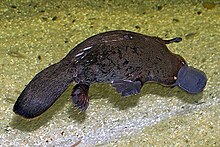platypus
Appearance
See also: Platypus
English
[edit]
Etymology
[edit]From New Latin Platypus (originally a genus name already in use for a type of beetle), from Ancient Greek πλατύπους (platúpous, “flat-footed”), from πλατύς (platús, “flat”) + πούς (poús, “foot”). Piecewise doublet of flatfoot.
Pronunciation
[edit]- (Received Pronunciation) IPA(key): /ˈplætɪpəs/
Audio (Received Pronunciation): (file)
- (General American) IPA(key): /ˈplætɪˌpʊs/, IPA(key): /ˈplætɪpəs/
Audio (General American): (file)
- Hyphenation: pla‧ty‧pus
Noun
[edit]platypus (plural platypuses or platypus or (common, hypercorrect) platypi or (rare) platypodes)
- A semi-aquatic, egg-laying monotreme mammal with a bill resembling that of a duck, that has a mole-like body, a tail resembling that of a beaver, a waterproof pelt, and flat webbed feet – males have poisonous spurs on the inside of the back legs; Ornithorhynchus anatinus.
- Synonyms: duck-billed platypus, duckbill, duckmole, mallangong, tambreet, water mole
- 2008 March 2, “Captive platypus twins make history”, in ABC News[1]:
- Victoria's Healesville Sanctuary is celebrating the births of two baby platypuses, in a major milestone.
- For more quotations using this term, see Citations:platypus.
Derived terms
[edit]Translations
[edit]Ornithorhynchus anatinus
|
See also
[edit]References
[edit] platypus on Wikipedia.Wikipedia
platypus on Wikipedia.Wikipedia  Ornithorhynchus anatinus on Wikispecies.Wikispecies
Ornithorhynchus anatinus on Wikispecies.Wikispecies  Category:Ornithorhynchus anatinus on Wikimedia Commons.Wikimedia Commons
Category:Ornithorhynchus anatinus on Wikimedia Commons.Wikimedia Commons
Categories:
- English terms derived from Proto-Indo-European
- English terms derived from the Proto-Indo-European root *pleth₂-
- English terms derived from the Proto-Indo-European root *ped-
- English terms derived from New Latin
- English terms derived from Ancient Greek
- English piecewise doublets
- English 3-syllable words
- English terms with IPA pronunciation
- English terms with audio pronunciation
- English lemmas
- English nouns
- English terms with quotations
- en:Monotremes
